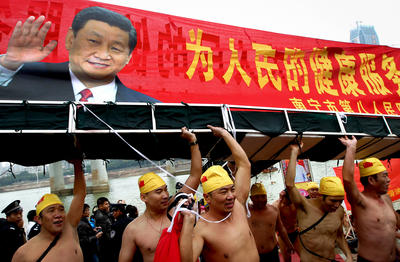Back then, the number of ministries went from 70 to 44 — this year the 44 ministries are expected to cut in half with portfolios redistributed.
This would be a further step away from China’s legacy of Leninist state administration,. More importantly it signals a new phase of political restructuring, which could potentially resolve the long power struggle in China.
No detail is set in stone yet, but something like the following could happen: the Ministry of Railways, which has managed to avoid incorporation into the Ministry of Transport for 15 years, will be abolished, while the Ministries of Civil Affairs, Labor and Social Security, and perhaps even of Health will be merged together.
The powerful Ministry of National Security, a sort of CIA and FBI created decades ago as a Chinese version of the Soviet KGB, will be downgraded, at least officially (but form counts). The Ministry of the Environment is also expected to expand its powers.
The Academy of Sciences and Academy of Social Sciences are likely to merge, despite playing very different roles. One is a research centre of science and technology; the other is a kind of super think tank for the government.
The powerful National Development and Reform Commission (NDRC), which is currently akin to a super Ministry of Economy and Industry, could disappear then reappear as a commission for reform, with tasks including administrative restructuring of the state.
The People’s Bank of China (PBOC), now a kind of technical body under the supervision of a deputy prime minister, should be promoted in rank and earning power.
In addition, the bloated state-owned enterprises (SOEs), which until recently had expanded their areas of interest and taken everything they could get their hands on, will face more pressure to focus on their core businesses. This should create more opportunities for private companies.
This will be a huge tectonic shift that should create greater efficiency for the state and the market, but will also create an army of malcontents. The restructuring will deal a strong blow to the bureaucracy.
Just 15 years ago, when China dramatically cut back its bureaucracy under then-president Jiang Zemin, the situation was very different.
In 1998, Beijing had a sense of anxiety about the inefficiency of the entire apparatus of the state, starting with SOEs. There was a pressing need for action when the Asian financial crisis put Beijing in danger of collapse.
Today all that has changed. Asia has been the locomotive of growth in recent years, and due to their many privileges, SOEs are full of money. In theory, then, China could continue with its old formula.
Yet the current leadership sees problems with the current system and wants to avoid bubbles of inefficiency that may expand and burst over the next 5–10 years. Already, SOEs are closing off the market to all but the most efficient private enterprises, and many ministries have no clear boundaries. This expands the bureaucracy and wastes time.
In reality, the pending reforms are advanced preparation, carried out without alarm or terror, to test how the Chinese ruling class can dominate the domestic situation and state apparatus — a much greater challenge than in the past, when the reforms were ‘forced’ by the external environment.
These reforms also take place at a strange moment during the transfer of power. In late March, President Hu Jintao and Premier Wen Jiabao will formally give up their state seats to Xi Jinping and Li Keqiang, respectively. So the changes underway are designed and driven jointly by the outgoing and incoming teams.
This is very different from 1998. Then, Jiang was able to push reforms that were firmly in his power, and the previous management team was physically out of the picture: Deng Xiaoping died in 1997, and most of his comrades in arms also departed the political scene.
Xi seems determined to build the Chinese equivalent of the American Dream — a dream of prosperity for the Chinese and peaceful development. In recent speeches Xi proved willing to continue and expand changes, and various signals increasingly suggest the possibility of political reforms.
To create his Chinese dream, Xi, supported by Hu, needs a lot of power and determination, because interest groups opposed to reforms are very powerful. Bo Xilai has been defeated, but many of his former supporters still defend his conservative ideas and protect the old ministries and cash-rich SOEs.
It is a delicate balancing act. But Hu Jintao and Xi Jinping appear to be working closely together to define the political direction of China for the next 20 years.
Francesco Sisci is a columnist for Il Sole 24 Ore and is based in Beijing, China.
A version of this article was first published here by Asia Times Online.

